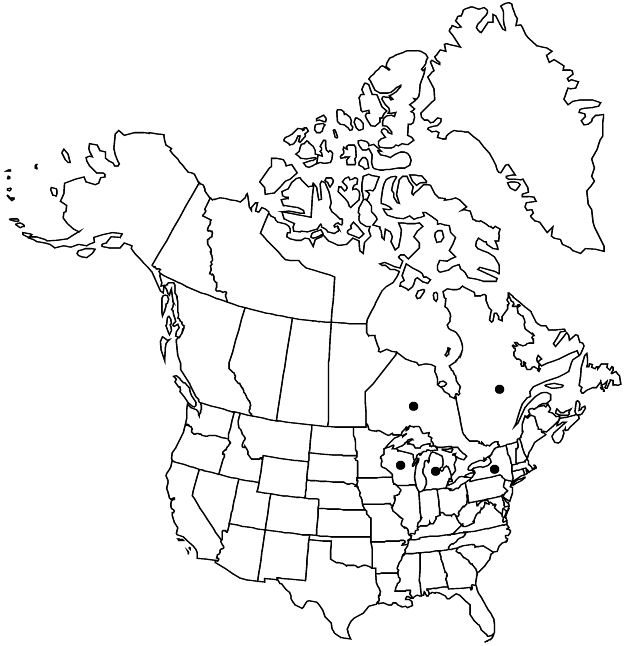Difference between revisions of "Crataegus lumaria"
J. Elisha Mitchell Sci. Soc. 19: 25. 1903.
FNA>Volume Importer |
FNA>Volume Importer |
||
| Line 15: | Line 15: | ||
|name=Crataegus dodgei var. lumaria | |name=Crataegus dodgei var. lumaria | ||
|authority=(Ashe) Sargent | |authority=(Ashe) Sargent | ||
| − | }}{{Treatment/ID/Synonym | + | }} {{Treatment/ID/Synonym |
|name=C. jackii | |name=C. jackii | ||
|authority=Sargent | |authority=Sargent | ||
| Line 33: | Line 33: | ||
|elevation=30–300 m | |elevation=30–300 m | ||
|distribution=Ont.;Que.;Mich.;N.Y.;Wis. | |distribution=Ont.;Que.;Mich.;N.Y.;Wis. | ||
| − | |discussion=<p>Crataegus lumaria is sporadic through much of its range; it is locally common in southern Ontario.</p><!-- | + | |discussion=<p><i>Crataegus lumaria</i> is sporadic through much of its range; it is locally common in southern Ontario.</p><!-- |
| − | --><p>Crataegus lumaria is much like a hairy-inflorescence form of C. dodgei. The disjunct C. jackii is a form with particularly hairy, suborbiculate leaves and larger flowers (to 20 mm).</p> | + | --><p><i>Crataegus lumaria</i> is much like a hairy-inflorescence form of <i>C. dodgei</i>. The disjunct C. jackii is a form with particularly hairy, suborbiculate leaves and larger flowers (to 20 mm).</p> |
|tables= | |tables= | ||
|references= | |references= | ||
| Line 58: | Line 58: | ||
|publication year=1903 | |publication year=1903 | ||
|special status=Endemic | |special status=Endemic | ||
| − | |source xml=https://jpend@bitbucket.org/aafc-mbb/fna-data-curation.git/src/ | + | |source xml=https://jpend@bitbucket.org/aafc-mbb/fna-data-curation.git/src/8f726806613d60c220dc4493de13607dd3150896/coarse_grained_fna_xml/V9/V9_1039.xml |
|subfamily=Rosaceae subfam. Amygdaloideae | |subfamily=Rosaceae subfam. Amygdaloideae | ||
|tribe=Rosaceae tribe Gillenieae | |tribe=Rosaceae tribe Gillenieae | ||
Revision as of 18:14, 18 September 2019
Shrubs or trees, 50 dm. Stems: twigs: new growth often ± reddish young, glabrous, 1-year old gray-brown, older dull gray; thorns on twigs ± recurved, 1-year old shiny, dark brown or black, older gray, slender, 2.5–7 cm. Leaves: petiole length 40–60% blade, glabrous, sparsely to densely minutely glandular; blade green, broadly rhombic to rhombic-ovate, or narrowly ovate to broadly elliptic, 2–4(–5) cm, thin, base rounded to cuneate, lobes 3 or 4 per side, sinuses shallow, lobe apex acute, margins serrate, veins 4–6 per side, apex acute to obtuse, abaxial surface glabrous, adaxial glabrate young, soon glabrescent. Inflorescences 6–15-flowered; branches pilose; bracteoles usually hyaline, linear, membranous, margins of proximal bracteoles usually stipitate-glandular. Flowers 13–18 mm diam.; hypanthium glabrous; sepals narrowly triangular, 5 mm, margins entire, glandular; stamens 10, anthers ivory; styles 2 or 3. Pomes yellowish, dull orange, or reddish, suborbicular, 7–12 mm diam., glabrous; sepals reflexed; pyrenes 2 or 3. 2n = 68.
Phenology: Flowering May; fruiting Sep–Oct.
Habitat: Brush, fallow pastures
Elevation: 30–300 m
Distribution

Ont., Que., Mich., N.Y., Wis.
Discussion
Crataegus lumaria is sporadic through much of its range; it is locally common in southern Ontario.
Crataegus lumaria is much like a hairy-inflorescence form of C. dodgei. The disjunct C. jackii is a form with particularly hairy, suborbiculate leaves and larger flowers (to 20 mm).
Selected References
None.